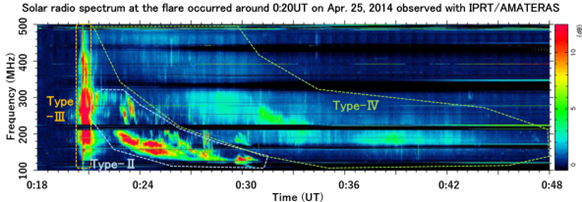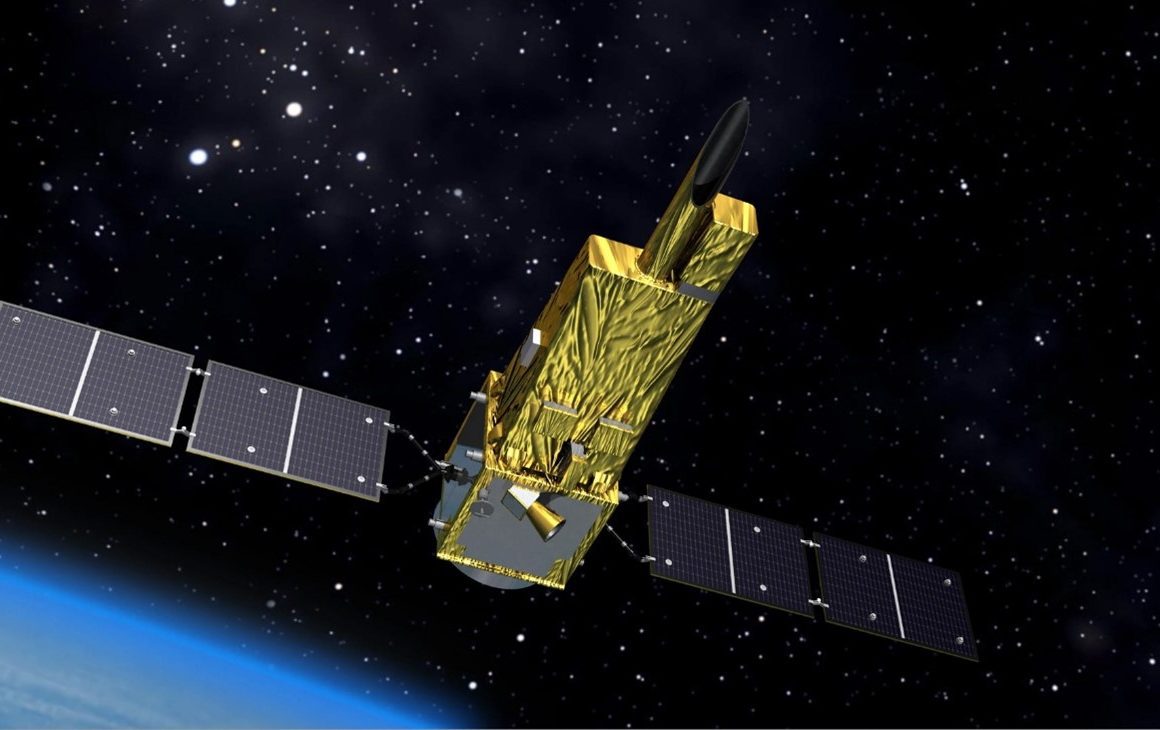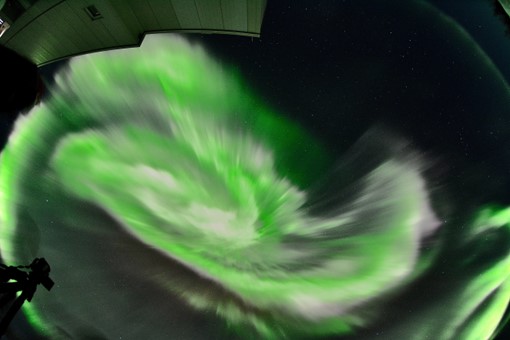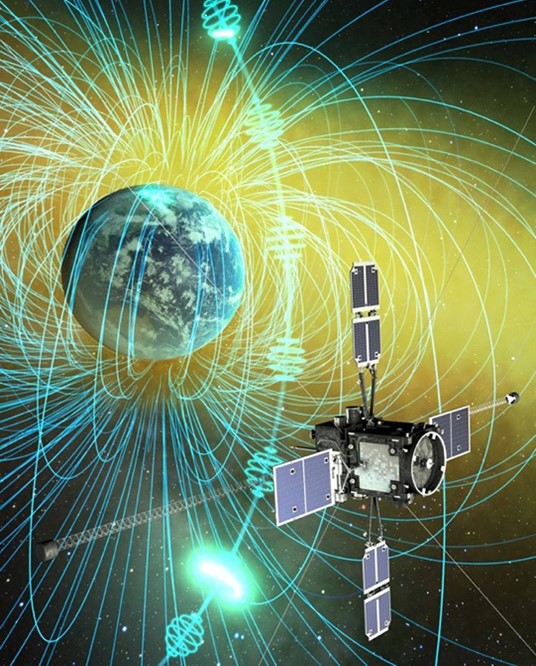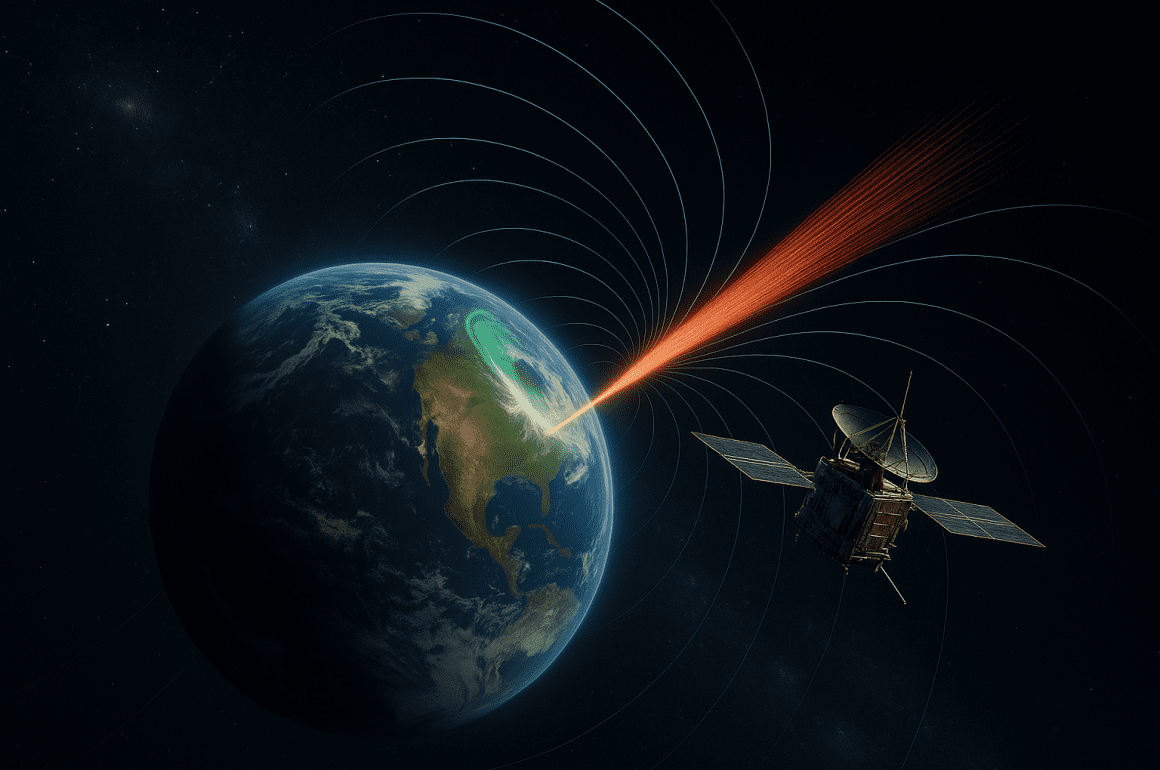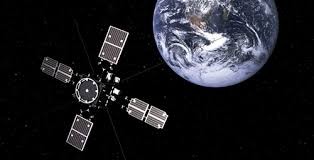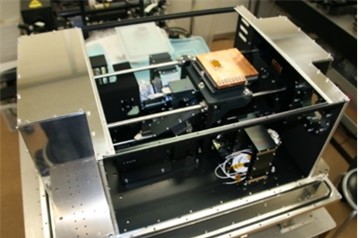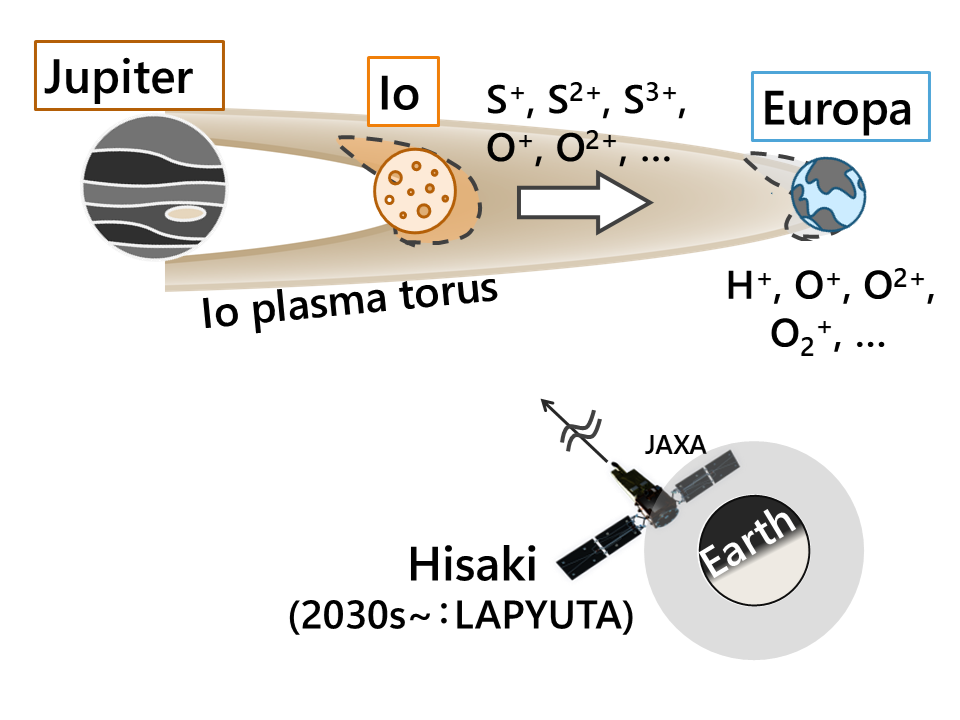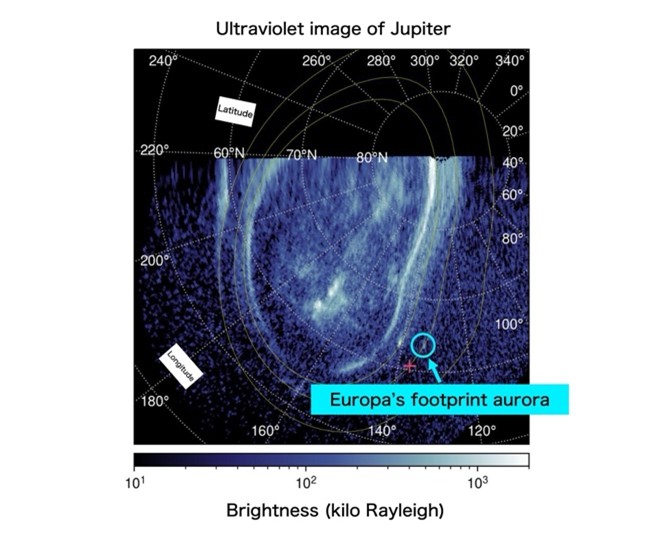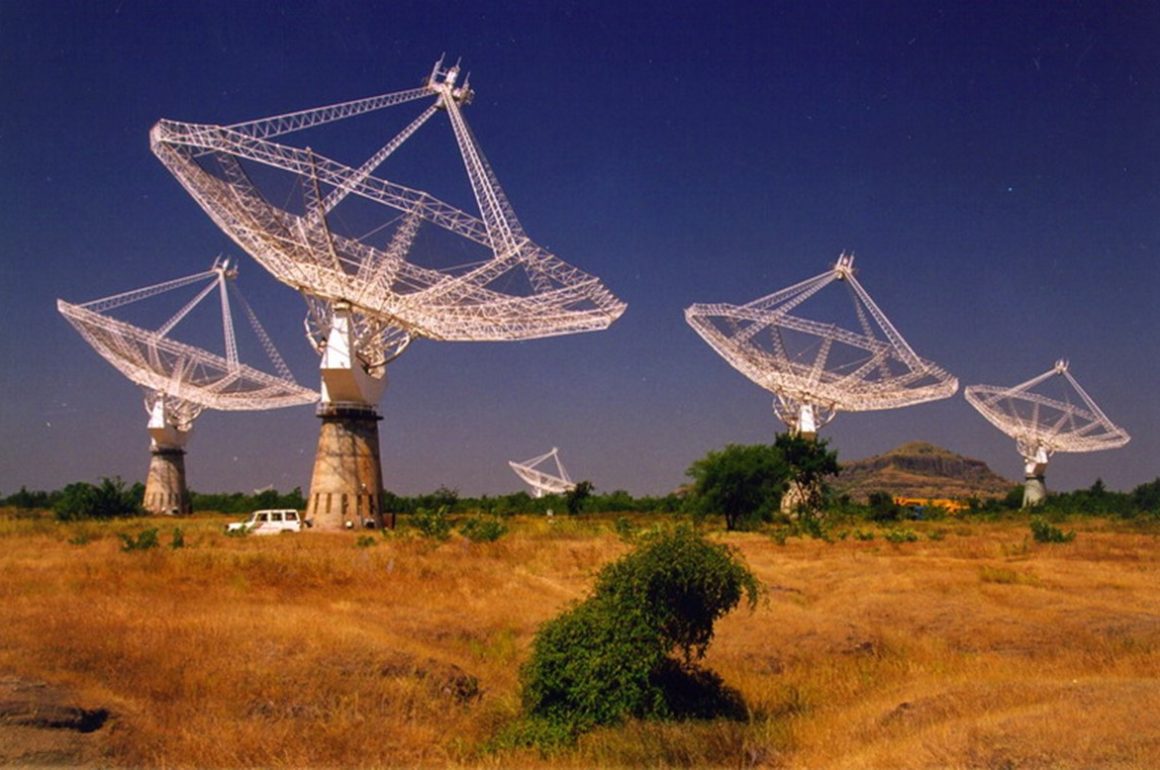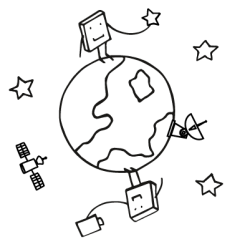Sun see details
Sunspots are regions where strong magnetic fields exist. Occasionally, the configuration of these magnetic fields undergoes sudden changes, releasing enormous amounts of energy in a short time. This phenomenon is called “flare”. During a flare, high speed particles are generated in the corona above the sunspot regions. These particles become the energy source of various radio waves, those carry information on the particle origin — where and how the particles generated by the flare and acquired their energy — and about the coronal environment, in which they propagated to reach the observer.
We daily conduct high-resolution solar radio observations using AMATERAS (the Assembly of Metric-band Aperture TElescope and Real-time Analysis System) installed on IPRT (the Iitate Planetary Radio Telescope), which enables high-time and high-frequency resolution of solar radio spectra observations. Using this system we have obtained numerous results, including the identification of diverse spectral building blocks of solar radio waves to elucidate their generation processes, and detailed spectral shape to uncover radio wave acceleration processes and the existence of fine density fluctuations in the propagating region of the corona.
Solar radio frequencies carry information on plasma density in their source regions. Measuring higher (lower) frequency radio waves provides information on radio emission and propagation in the regions closer (farther) to the Sun. We are currently advancing plans to expand our observational frequency range further, aiming to explore the dynamic plasma conditions across a broader region of the corona. (Author: H. Misawa)
Mercury see details
Tohoku University utilizes a remotely controlled 60 cm aperture telescope (T60) located at the summit of Haleakalā, Maui, Hawaii. This enables continuous, unparalleled observations of solar system bodies. A Fiber-fed Integral Field Spectrograph (IFS) attached to this telescope allows for flexible modification of the light path using optical fibers, making it possible to capture
the two-dimensional spatial distribution of a specific wavelength at a particular moment.
I am using this Fiber-fed IFS to capture and observe the atmosphere of Mercury in two dimensions. Mercury possesses a tenuous atmosphere, far thinner than the altitude at which the International Space Station orbits, composed of elements like alkali metals evaporating from the surface. Among these, the emission from neutral sodium is bright and widely extended due to
solar illumination, making its distribution and variation detectable through ground-based observations.
This research aims to conduct simultaneous observations with the joint European-Japanese mission BepiColombo, which is scheduled to enter Mercury’s orbit at the end of 2026. By combining ground-based and spacecraft data, we seek to understand the distribution, variations, and underlying mechanisms of Mercury’s tenuous atmosphere. Mercury, unlike the Moon, possesses a magnetosphere, and its sodium atmosphere is influenced by it, leading to variations on a timescale of mere minutes. I hope that by capturing the changes in the spatial distribution that our instrument is beginning to detect, we can unravel the mechanisms driving these variations, and that is the goal of our observations.Written by TAKATORI Naoko.
Venus see details
Venus is believed to have once possessed a substantial amount of water, but today it is an extremely dry planet.
One of the key processes behind this transformation is known as atmospheric escape — the loss of atmospheric particles into space.
This research aims to understand how the solar wind, a high-energy stream of charged particles emitted by the Sun, influences the hydrogen-rich upper atmosphere (exosphere) of Venus. Written by NOSE Chizuru.
Earth see details
We observe auroral emissions from both space and ground, and combine them with satellites and ground-based radar to promote a comprehensive understanding of auroral physics.
Certain types of auroras are of interest because of the very high energy precipitating electrons that affect the middle atmosphere. We launched the LAMP rocket in 2022, the first in the world to successfully observe these phenomena simultaneously. We also plan to launch the LAMP-2 rocket.
On the other hand, the high-latitude polar cap region, which is directly affected by the solar wind, is attracting attention from the perspective of space weather. We have developed 10 all-sky cameras and constructed an observation network that covers a wide area over the Antarctic Continent. Written by SAKANOI, Takeshi.
‘Geospace’ is the space around the Earth that consist of plasma (charged particles) originating from the Earth’s atmosphere and the solar wind. The electromagnetic waves propagating in the plasma are called ‘plasma waves’. In space, collisions between particles rarely occur, but the motion of particles is scattered by ‘collisions’ between plasma waves and charged particles. As a result, the enegetic particles precipiatte into the Earth’s atmosphere and cause polar auroras and affect the composition in the upper atmosphere. Therefore, studying the generation and propagation of plasma waves is important topic for understanding the connection between space and the Earth’s atmosphere. Using observations of plasma waves by the Arase satellite and groundbased aurora observations, we are investigating how plasma waves propagate through geospace and scatter enegetic charged particles, and studying the effects of space on the Earth’s atmosphere. Written by TSUCHIYA, Fuminori.
Have you heard that “Earth is like a giant magnet”? This magnet creates a vast region called the magnetosphere, which acts like a protective shield from the stream of charged particles known as the solar wind.
I study what’s going on inside this magnetosphere—especially what kinds of ions (electrically charged particles) are there, where they are, and how many of them exist by analyzing ElectroMagnetic Ion Cyclotron (EMIC) waves which are excited by ions traveling through the magnetosphere. Right now, I’m working with data from JAXA’s Arase satellite to try to uncover the types and ratios of ions present in the magnetosphere.
This research is expected to be applied to other planets. For example, BepiColombo is scheduled to arrive at Mercury in 2026, and JUICE will begin orbiting Jupiter in 2031. By applying this method, we hope to open new ways to explore particles and plasma environments surrounding planets. Written by KIKUCHI Riku.
Auroras glow above the Arctic and Antarctic. Far above them, powerful radio emissions known as Auroral Kilometric Radiation (AKR) are emitted into space at frequencies corresponding to the medium wave band. The intensity and frequency of this radiation are closely linked to various phenomena and structures within Earth’s magnetosphere that drive auroral activity. It also serves as an indicator showing the overall activity level in real time.
The Japan-U.S. joint satellite Geotail continuously observed this radio activity for approximately 30 years, from its launch in 1992 until 2022. This marks the first time such high-quality observations have been made by a single satellite over such an extended period. It spans three solar activity cycles, providing invaluable data for studying the effects of solar activity on Earth. Through long-term statistical analysis of this unique data, we aim to deepen our understanding of the Earth’s magnetosphere by examining the occurrence characteristics and variability trends of AKR.
Such radio activity is observed across planets. We anticipate research developments for Mercury, where the joint Japanese-European BepiColombo orbiter will begin observations in 2026; Jupiter, where the European JUICE orbiter will start observations in 2031; Saturn, explored by the US Cassini probe in the 2000s-2010s; and the two icy giant planets, Uranus and Neptune, for which future exploration plans are under consideration. Written by YAMANAKA Haruto.
The JAXA Arase satellite, which traverses the Earth’s radiation belts, investigates plasma activity extending from the ionosphere to regions beyond geostationary orbit. One of its primary observation targets is electron density, derived from the frequency of a wave known as the Upper Hybrid Resonance (UHR) detected by electric field antennas. However, in regions where the electron density is low and the wave signal is weak, the measurement accuracy decreases. In space, a satellite becomes electrically charged through the balance between incoming ambient electrons and photoelectrons emitted by sunlight.
By analyzing variations in this spacecraft potential, together with direct electron particle measurements, we have examined more than eight years of data collected since Arase’s launch in 2017. Since electron inflow depends on both electron density and temperature, this method provides valuable insight into how these parameters vary from the ionosphere up to the magnetosphere. Furthermore, spacecraft potential serves as a foundation for measuring electric fields that accelerate electrons and ions to high energies in space.
This study not only contributes to improving the accuracy of space electric field measurements, but also supports observations of the BepiColombo mission, a joint Japan–Europe project that will begin orbiting Mercury at the end of 2026. Written by KAWAGATA Keiya.
Mars see details
I analyze the Martian atmosphere using observational data obtained by the near-infrared imaging spectrometer OMEGA onboard the European orbiter Mars Express. The Martian atmosphere contains abundant dust particles, which absorb and scatter sunlight, giving rise to various weather phenomena unique to Mars. To understand these phenomena, I have been collaborating with a French research team to develop a system that retrieve the dust optical depth, dust altitude profile, and surface pressure. This system will be applied to future Mars exploration missions, including the MMX (Martian Moons eXploration) mission scheduled for launch in 2026. Written by KAZAMA Akira.
Jupiter see details
We are developing a near-infrared camera (TOPICS) and a high-dispersion Echelle spectrograph (wavelength resolution ~20,000) for near-infrared observations installed on the Haleakala T60 telescope. These near-infrared observations will enable the observations of Jupiter’s infrared auroras and volcanic activity on Io. By combining these observations with visible observation of the T60 telescope, we aim to elucidate the material and energy transport mechanisms within the Jupiter’s magnetosphere.
In addition, this instrument apply to detect trace gas components (methane, hydrogen peroxide, HDO/H₂O) that contribute to the understanding of the physical mechanisms of the Martian atmospheric environment, including dust storms.
This ground-based observation is also significant for future collaborative observations with space probes such as the Jupiter exploration mission JUICE and the Mars exploration mission MMX. Written by SAKANOI, Takeshi
Jupiter possesses an exceptionally strong magnetic field, and within its magnetosphere lies a vast distribution of plasma released from its volcanically active moon, Io. This plasma forms a structure known as the Io plasma torus, from which narrowband kilometric radiation (nKOM) is emitted.
The objective of my research is to investigate the long-term variations in the occurrence frequency and intensity of nKOM emissions, in order to clarify their relationship with magnetospheric dynamics such as injection phenomena within Jupiter’s magnetosphere. Written by SUGAWARA Rentaro.
We focus on the volcanically active Io and the icy moon Europa. Sulfur and oxygen ions generated from Io spread to Europa’s orbit as a doughnut-shaped Io plasma torus. However, time and spatial continuity of plasma parameters at Europa’s orbit has rarely been investigated because of the limited observations. This study aims to estimate the electron density, electron temperature, and ion composition in Io plasma torus from Io’s orbit to Europa’s orbit using Hisaki satellite data. As a result, the sulfur and oxygen ion emission lines were successfully identified at Europa’s orbit. We will work on how the plasma density and ion composition at Europa’s orbit changed in response to Io’s volcanic activity occurred in late January 2015. Written by MATSUSHITA Natsuko.
Jupiter’s polar regions exhibit auroral emissions with complex structures. The “footprint aurora” associated with Europa is a signature of the plasma environment around Europa. Using the observations of the footprint aurora made by the Hubble Space Telescope, I detected temporal variations in the plasma mass density and temperature around Europa. Currently, I am continuing my research using the high spatial resolution data obtained by the Juno spacecraft. A detailed investigation of the footprint aurora will lead to a deeper understanding of the plasma environment surrounding Europa. Written by SATOH Shinnosuke.
Jupiter’s synchrotron radiation (JSR) is emitted from the high-energy electrons trapped in the Jupiter’s radiation belts. Its intensity and frequency depend on electron energy, electron number density, and magnetic field strength.
We are observing the JSR with several telescopes, including the Giant Metrewave Radio Telescope (GMRT) in India, and analyzing the data to estimate the spatial structure and energy spectrum of electrons in Jupiter’s radiation belts. Written by Waga Masamichi.
Saturn see details
In this study, we focus on the refraction of planetary radio emissions as they pass through the ionospheres of moons—electrically charged layers of the atmosphere—and develop a method to derive electron densities from their bending behavior. Conventional observation techniques have limitations in spatial coverage. To address this, we propose a new approach that simulates the radio wave paths through the ionospheres using computer-based ray tracing and inversely estimates the electron density. We are currently applying this method to derive the electron density distribution of Titan’s ionosphere using data from the Cassini spacecraft. Furthermore, in preparation for the upcoming JUICE mission, we are investigating the use of radio wave polarization (i.e., rotational direction) to improve the accuracy of the analysis. Written by YASUDA Rikuto.








